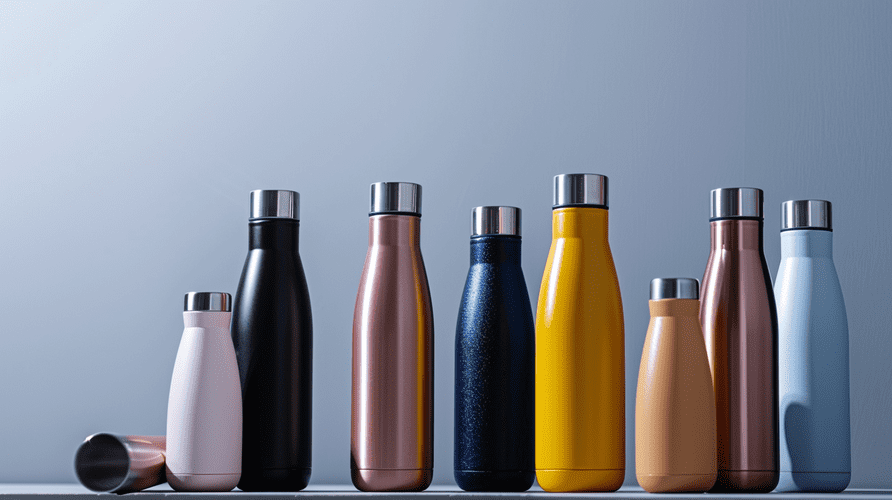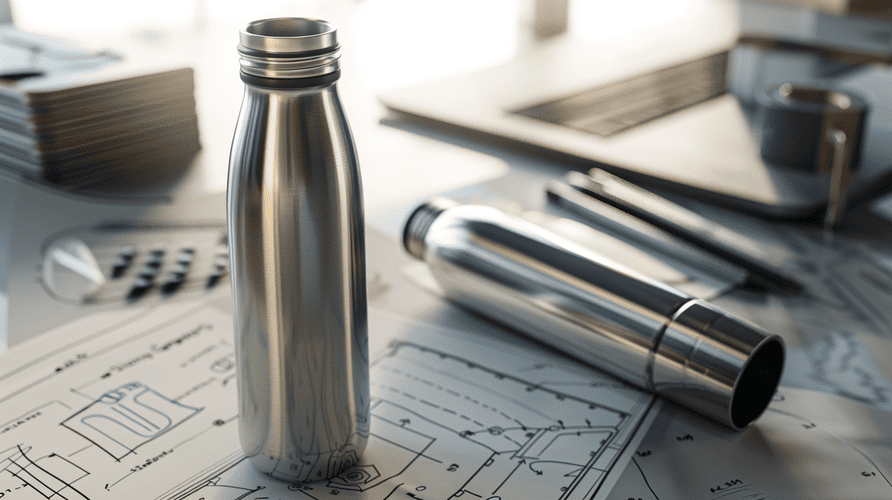Worried about lead in your bottle? Hidden dangers can be scary. I will show you how to pick a safe, lead-free insulated water bottle.
Choosing a lead-free insulated water bottle means picking one made from food-grade stainless steel, like 18/8 or 304. Good manufacturers will test their materials. They can prove their bottles are safe for you to use every day.

I understand that picking the right water bottle is a big decision. It affects your health and peace of mind. So, let's look closer at what makes an insulated water bottle truly lead-free. We need to make sure you have all the facts to choose wisely.
What insulated water bottles are lead free?
Confused about "lead-free" labels? Some bottles might still hide lead. I will help you find the ones that are genuinely safe and protect your health.
Truly lead-free insulated water bottles1 use high-grade stainless steel, like 18/8 or 304, for every part that touches your drink. They also use safe methods to seal the vacuum insulation, avoiding lead solder, which can be a hidden problem.

Dive Deeper: Uncovering Lead-Free Manufacturing Secrets
When I talk to clients like Mark Shenng, a company owner in Canada, their top concern is often product safety, especially regarding lead. He knows his customers trust him for quality. So, understanding where lead might come from is key.
Understanding Lead Contamination Sources
Lead was sometimes used in a small sealing dot on the bottom of insulated bottles. This dot seals the vacuum. If this dot contains lead, and it's not properly covered or it gets damaged, lead could potentially become an issue. Though the liquid inside usually doesn't touch this part, the risk, however small, is something we at Icobottle take very seriously. We ensure our sealing processes are completely lead-free.
Identifying Lead-Free Features and Supplier Checks
So, how can you be sure?
- Material Specification: Always ask for 18/8 or 304 stainless steel2 for all components in contact with beverages.
- Sealing Process: Inquire about the sealing method for the vacuum insulation. Reputable manufacturers now use lead-free solder or alternative methods like a glass bead.
- Third-Party Testing: Ask for test reports from certified labs. These reports should confirm the absence of lead and other heavy metals. I always provide these to my clients. It builds trust.
- Supplier Reputation: Work with suppliers who are transparent about their manufacturing processes.
Here’s a quick comparison:
| Feature | What to Look For | Why It Matters |
|---|---|---|
| Bottle Material | Food-grade 18/8 (304) Stainless Steel | Non-leaching, rust-proof, durable |
| Insulation Seal | Lead-free solder / Glass bead sealing | Prevents potential lead exposure |
| Certifications | FDA, LFGB, Prop 65 compliance reports | Independent verification of safety |
| Supplier Practice | Transparency, readily available tests | Shows commitment to quality |
Choosing a supplier who openly discusses these points is crucial. As a B2B supplier myself, I know that clear communication and verifiable quality are what procurement officers need.
What is the healthiest type of water bottle to use?
Want the very best for your daily hydration? Many bottle materials are out there. I will guide you to the healthiest choices for your well-being.
Stainless steel, especially food-grade 304 (or 18/8), and glass bottles are generally the healthiest. They do not leach harmful chemicals into your water. They are also easy to clean and do not hold onto old tastes or smells.

Dive Deeper: Comparing Materials for Optimal Health
When I started Icobottle, my goal was to provide top-quality, safe products. The choice of material is a big part of that. Let's look at why some materials are better for your health.
Why Stainless Steel Shines
Food-grade stainless steel, like the 304 grade we use for our hip flasks and water bottles, is a champion for health.
- Inertness: It doesn't react with beverages. So, your water tastes like water, not like the bottle.
- Non-leaching: It doesn't release chemicals, even with hot or acidic drinks. This is a major concern with some plastics.
- Durability: It's tough and can last for years. This reduces waste and exposure to degrading materials.
- Hygiene: It's easy to clean and resists bacteria growth, especially if it has a smooth interior.
The Purity of Glass
Glass is another excellent choice.
- Purity: It's completely inert and won't leach anything.
- Taste: Like stainless steel, it preserves the pure taste of your drink.
- Transparency: You can easily see if it's clean.
The main downside is fragility. I've seen clients who love glass but worry about breakage, especially for active use or when sourced for retail where damage can occur.
Considerations for Other Materials
Plastic bottles3 are common, but they come with concerns. Some plastics can leach chemicals like BPA or phthalates, especially when heated or old. Even "BPA-free" plastics might have other chemicals that we don't fully understand yet. For my B2B clients, consistency and guaranteed safety are paramount, which is why we focus on stainless steel.
Here’s a simple comparison:
| Material | Health Aspects | Cleanability | Durability |
|---|---|---|---|
| Stainless Steel | Inert, non-leaching, no BPA/phthalates | Easy | Very High |
| Glass | Inert, non-leaching, no BPA/phthalates | Easy | Low |
| Plastic | Risk of leaching (BPA, phthalates, others) | Moderate | Medium |
| Aluminum | Often lined with plastic; raw aluminum can leach | Moderate | Medium |
For health, stainless steel and glass are clear winners. For practical daily use, especially in an insulated bottle, stainless steel often has the edge due to its durability.
Is 304 or 316 stainless steel better for water bottles?
Choosing between steel grades like 304 and 316 can seem very technical. You want the best durability and safety. I will explain which steel is best for your water bottles.
For most water bottles, 304 stainless steel (also known as 18/8) is excellent. It offers great resistance to rust and is very safe. 316 stainless steel has even more rust resistance but is usually not needed and costs more for water bottles.

Dive Deeper: Understanding Stainless Steel Grades for Your Bottle
When procurement officers like Mark from Canada ask me about stainless steel grades, they want to ensure they're getting value and quality. They are sensitive to quality but also seek competitive pricing. Let's break down 304 and 316 stainless steel4.
Decoding Stainless Steel Grades: What's the Difference?
The numbers refer to the composition of the steel.
- 304 Stainless Steel (18/8): This is the most common food-grade stainless steel. It contains roughly 18% chromium and 8% nickel. This composition gives it excellent corrosion resistance5 for most applications, including food and beverages. It's strong and easy to clean.
- 316 Stainless Steel: This grade has a similar amount of chromium and nickel as 304, but it also includes about 2-3% molybdenum. Molybdenum significantly increases its resistance to corrosion, especially from chlorides (like salt) and harsh industrial chemicals.
304 Stainless Steel: The Industry Standard for Water Bottles
For water bottles, coffee mugs, tumblers, and hip flasks, 304 stainless steel is almost always the perfect choice.
- Sufficient Corrosion Resistance: Water, coffee, tea, and most other everyday drinks won't corrode 304 stainless steel.
- Cost-Effectiveness: It's less expensive to produce than 316, making the final product more affordable without compromising safety or essential quality. This is important for my B2B clients who need competitive pricing.
- Proven Safety: It has a long history of safe use in food and beverage applications. All our Icobottle products use high-quality 304 stainless steel.
When Might 316 Be Considered?
316 stainless steel is superior in highly corrosive environments. Think marine applications (exposure to saltwater) or industrial settings with strong acids. For a water bottle, this level of protection is usually overkill. You would be paying for a feature you don't really need. I've rarely had a request for 316 for standard drinkware because 304 performs so well.
Here's a comparison for water bottle use:
| Feature | 304 Stainless Steel (18/8) | 316 Stainless Steel |
|---|---|---|
| Composition | ~18% Cr, ~8% Ni | ~16-18% Cr, ~10-14% Ni, ~2-3% Mo |
| Corrosion Resistance | Excellent for everyday drinks | Superior, especially to chlorides |
| Food Safety | Excellent | Excellent |
| Cost | More economical | More expensive |
| Common Use in Bottles | Yes, industry standard | Rare, usually unnecessary |
So, my insight is clear: for a lead-free insulated bottle, pick one with 304 stainless steel. Then, confirm the maker does material safety tests. This ensures it is truly safe and gives you the best value.
Conclusion
Choose 304 stainless steel bottles. Verify lead-free sealing and material tests. This ensures a safe, healthy, and durable water bottle for your daily hydration needs.
-
Explore this link to discover top-rated insulated water bottles that are genuinely lead-free, ensuring your health and safety. ↩
-
Learn about the benefits of 18/8 and 304 stainless steel in water bottles, ensuring durability and safety for your beverages. ↩
-
Learn about the potential health risks of plastic water bottles, including chemical leaching, to make informed hydration choices. ↩
-
Learn about the specific scenarios where 316 stainless steel is beneficial, especially in highly corrosive environments, to make informed choices. ↩
-
Understanding corrosion resistance is crucial for selecting durable materials for water bottles, ensuring longevity and safety in use. ↩

